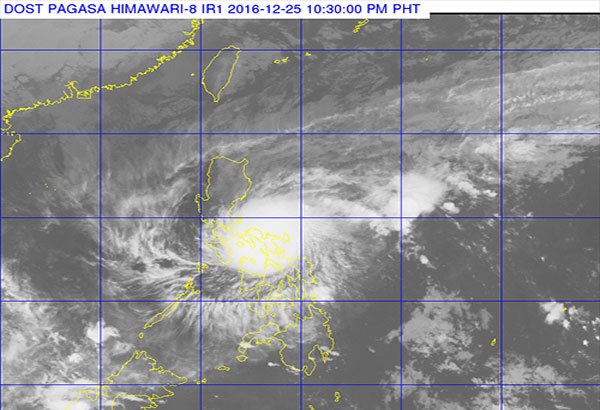Thousands flee homes as Nina slams Bicol

The Philippine Atmospheric, Geophysical and Astronomical Services Administration (PAGASA) raised tropical cyclone warning signal No. 2 over Metro Manila as of 5 p.m. yesterday. Screengrab from pagasa.dost.gov.ph
DARAGA, Albay, Philippines – Children and the elderly were loaded onto military trucks here yesterday as thousands fled from the path of Typhoon Nina.
The typhoon, (international name Nock-Ten) made landfall at 6:30 p.m. in Bato, Catanduanes.
It was expected to bring heavy rains and gusty winds as it traversed Southern Luzon, the state weather bureau warned yesterday.
The Philippine Atmospheric, Geophysical and Astronomical Services Administration (PAGASA) raised tropical cyclone warning signal No. 2 over Metro Manila as of 5 p.m. yesterday.
Officials warned that storm surges up to 2.5 meters high, landslides and flash floods posed the biggest threats as Nina closed in on the Bicol peninsula and nearby islands.
The typhoon threat, on one of the biggest holidays in the Philippines triggered preemptive evacuations that officials said could involve hundreds of thousands of people.
“We went around with megaphones and gave instructions to our people to eat breakfast, pack and board the military trucks,” said Alberto Lindo, an official of Alcala, a farming village of 3,300 people near the active Mayon volcano.
About 100 babies, toddlers, parents and elderly people were the first to be trucked off to a school some seven kilometers away as strong winds began to shake trees at midday yesterday, scattering leaves on the pavement.
“There are large ash deposits on the slopes (of Mayon). Heavy rain can dislodge them and bury our homes in mud,” Lindo warned.
PAGASA said Nina, or Nock-Ten, named after a bird found in Laos, was set to hit Bicol on Sunday evening.
PAGASA senior weather forecaster Rene Paciente said heavy rains and gusty winds were forecast over the National Capital Region after hitting Bicol region and crossing through the Southern Tagalog provinces beginning last night or this morning.
The eye of the storm will be nearest Metro Manila at around 2 p.m. Monday, according to Paciente.
The US Joint Typhoon Warning Center has forecast sustained winds of 231 kilometers an hour and gusts of 278 km when Nina makes landfall in Catanduanes.
The typhoon will eventually affect an area of nearly 42 million people, including Metro Manila today.
As of 4 p.m. yesterday, the eye of Nina was spotted at 65 kilometers east-southeast of Virac, Catanduanes with maximum sustained winds of 185 kilometers per hour near the center and gustiness of up to 255 kph. It was forecast to move west at 15 kph.
Nina was projected to directly hit Catanduanes last night then cross Albay, Camarines Sur, Camarines Norte, Southern Quezon, Laguna, Batangas and Cavite.
PAGASA placed Catanduanes and Camarines Sur under signal No. 4 – the second highest wind speed warning.
Nina could bring moderate to heavy rains in areas within its 500-km diameter.
PAGASA also raised signal No. 3 over Burias Islands, Albay, Camarines Norte, Southern Quezon, Sorsogon and Marinduque.
Aside from Metro Manila, signal No. 2 was hoisted over Masbate including Ticao Island, Oriental Mindoro, Batangas, Laguna, rest of Quezon including Polillo Island, Occidental Mindoro, including Lubang Island, Romblon, Cavite, Rizal, Bulacan, Bataan and Northern Samar.
Storm surges of up to 2.5 meters high are likely to hit the coastal areas of Albay, Sorsogon, Camarines Sur, Camarines Norte and Catanduanes, PAGASA said.
Signal No. 1, meanwhile, was raised over Pangasinan, Nueva Ecija, Aurora, Quirino, Nueva Vizcaya, Zambales, Pampanga, Calamian Group of Islands, Tarlac, Aklan, Capiz, Samar, Eastern Samar, Biliran, Leyte and Bantayan Island.
Paciente said cold air blowing from the north and an interaction with the Sierra Madre mountain range is expected to weaken Nina after landfall.
Flood advisories
Civil defense officials in Bicol said earlier nearly half a million people in the region were in harm’s way and needed to be evacuated.
The government called for preemptive evacuations in the area on Saturday, with nearly 4,000 residents moving into emergency centers and more than 8,000 others seeking shelter elsewhere, an official tally said.
Evacuations were continuing on Christmas Day as the military and local governments sent trucks to evacuate coastal communities and other areas hit by landslides or flash floods in previous storms.
PAGASA said flood advisories were issued for the following provinces: Zambales, Bataan, Aurora, Bulacan, Tarlac, Cavite, Laguna, Batangas, Rizal, Quezon, Occidental Mindoro, Oriental Mindoro, Marinduque and Palawan as of yesterday morning.
The agency advised residents particularly in the provinces of Catanduanes, Camarines Sur and Camarines Norte, Albay and Sorsogon to brace for possible flash floods.
Angat Dam in Bulacan has opened one floodgate since the reservoir’s water level is less than one meter short of its 212-meter spilling level, PAGASA said.
The agency advised residents living along the Angat River to be on alert when rainfall intensifies on Sunday evening as Nina makes landfall in Catanduanes.
Some 20 typhoons or lesser storms strike the Philippines each year, routinely killing hundreds of people, and Bicol is often the first region to be hit.
It prides itself on having honed its disaster response to minimize casualties.
“We have recalled all of our first responders from vacation. They will be on 24-hour standby and on call for rescues or support,” Rachel Miranda, spokeswoman for the region’s civil defense office said.
Nina, which will arrive outside the normal typhoon season, disrupted Christmas celebrations with ferry services and commercial flights suspended.
Some of the thousands of commuters stranded at dozens of ports that were closed for the typhoon spent the night inside evacuation centers yesterday.
After Bicol, Nina is forecast to strike the heavily populated heartland of the main island of Luzon including Metro Manila.
Rescue workers in the capital have been put on standby, evacuation centers opened and food and other rations stocked.
The Philippine Coast Guard yesterday ordered the beaches south of Manila to be cleared of holidaymakers today, while residents of the capital’s seaside slums were warned to leave their homes.
Mammoth tsunami-like sea waves devastated the city of Tacloban and nearby areas when Super Typhoon Yolanda (Haiyan) struck the central Philippines in November 2013, leaving 7,350 people dead or missing.
- Latest
- Trending





























